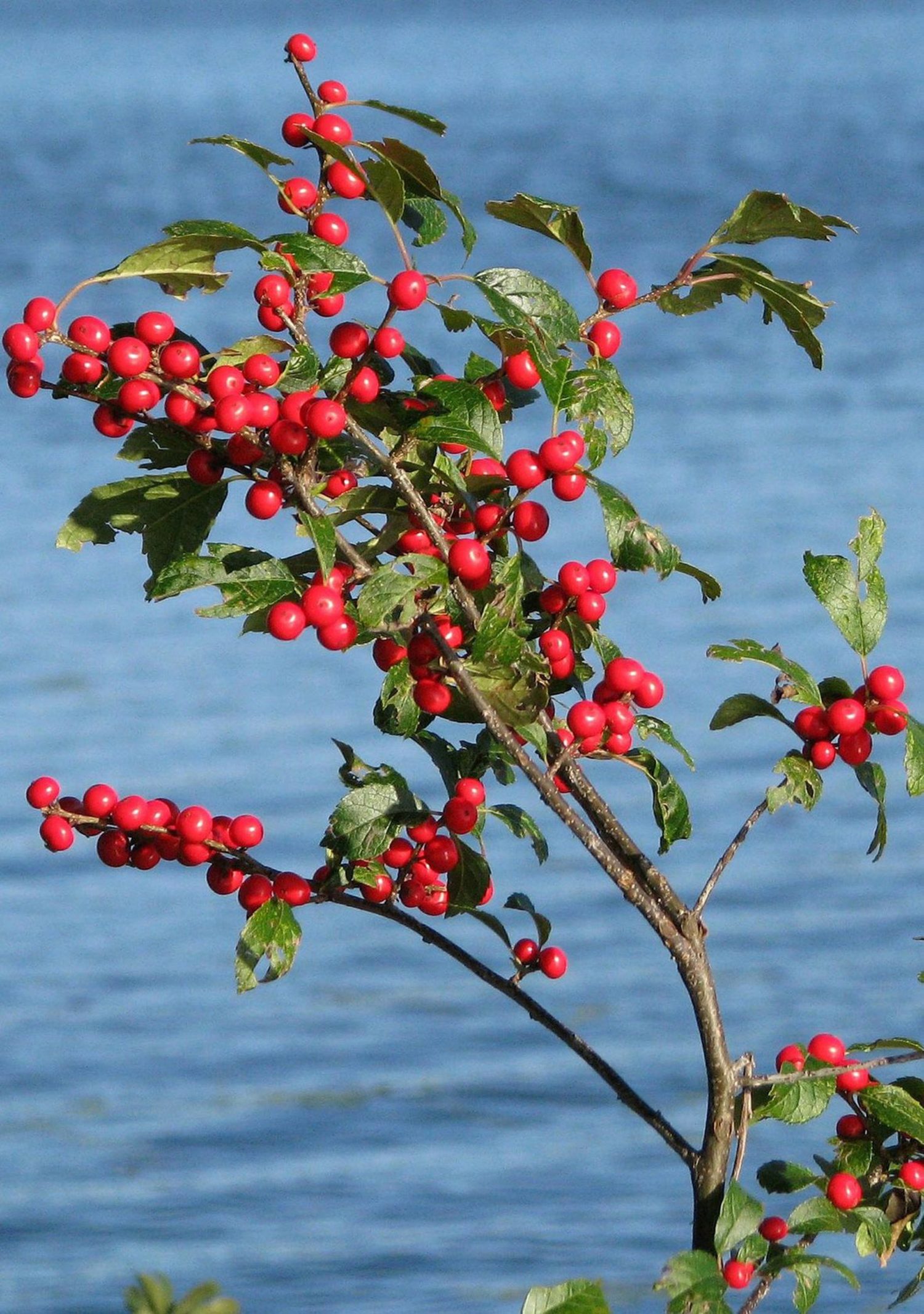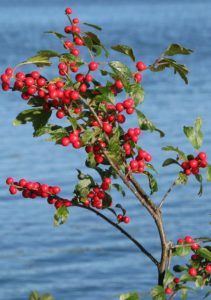
Winterberries for Winter Color
Winterberries bring a flash of scarlet to our color-starved northern winter landscape.
By Thomas Christopher
The law of supply and demand dictates that when something is in short supply, its value skyrockets. This is precisely what makes winterberry so precious. Ilex verticillata, our native winterberry, is an uninspiring shrub during the growing season, an expansive fountain of medium to dark green leaves that bears inconspicuous greenish-white flowers in late spring. And although this native shrub is a member of the holly genus, it isn’t evergreen. Nor do the leaves color in fall, they just fall from the twigs. When they do, though, they reveal the winterberry’s great gift. As the name suggests the branches are typically laden with vivid scarlet berries that gladden the hearts of gardeners in the color-starved northern winter. These fruits are also popular with birds ranging from wild turkeys and woodpeckers to cedar waxwings and over-wintering robins. Likewise, squirrels, rabbits, and foxes are likely to partake of this late season feast.
Ranging from the Atlantic provinces of Canada south to Texas and Florida, the winterberry naturally inhabits swamps, stream sides and moist lowlands, but it easily adapts to well-watered, acidic garden soils. In its natural state, this shrub is slow growing but can eventually attain a height and spread of twelve feet. Fortunately, plant breeders have developed a number of more compact cultivars. ‘Red Sprite’, for example, bears exuberant crops of large red berries but makes a shrub only 4 ft. tall by 4 ft. wide. ‘Shaver,’ is slightly larger at 6 ft. by 6 ft., and is remarkable in that it bears orange-red fruits. ‘Cacapon,’ which reaches a height 6 to 8 ft. bears glossy, dark green, crinkled leaves and heavy crops of true red fruits.
Larger cultivars that are outstanding berry producers include ‘Winter Red’ which grows to a height and width of 8 f.t and bears particularly heavy crops of red fruits which typically persist well into winter, and ‘Winter Gold’ (10 ft. by 10 ft.) whose pinkish-orange fruits mature to a rich gold.
The growth of winterberries tends to be slow, though regular watering and the application of appropriate doses of fertilizer will enhance it somewhat. The impatient gardener, however, may prefer the race of hybrids created by crossing Ilex verticillata with an Asian relative, the Japanese winterberry, Ilex serrata. These preserve the appearance of the familiar American winterberry but match it with more vigorous growth. Most popular of these is ‘Sparkleberry’ which reaches a height and width of 6 to 10 ft. This hybrid is also less hardy than the pure native types, over-wintering reliably only through zone 5.
Like all hollies, winterberry is dioecious. That is, it bears its male and female flowers on different shrubs. This means that in order for your female specimens to bear fruit, there has to be a male plant nearby to fertilize them. Generally, a single male is sufficient to fertilize 5-10 female winterberries, which is good because the males have little to recommend them other than their ability to bring on fruiting in their female counterparts. Plant the male near to the females (within 50 feet), but in someplace inconspicuous. Complicating this issue of pollination is the fact that different strains of winterberry bloom at slightly different times, so that an early-blooming male may fail to pollinate a late-blooming female. Use the early-blooming male cultivar ‘Jim Dandy’ to pollinate early-blooming females ‘Red Sprite,’ ‘Shaver,’ and ‘Cacapon,’ and late-season male ‘Southern Gentleman’ to pollinate late-season females ‘Sparkleberry,’ ‘Winter Red,’ and ‘Winter Gold.’ Because they flower on new growth, winterberries should be pruned in early spring.
Though starring in the winter garden, winterberries are relatively plain plants in other seasons. As such, they may not deserve a central spot in the landscape, but, adapted as they are to full sun or partial shade, they make a fine shrub for backing up a flower garden or for massing at the edge of a woodland. Their tolerance for wet soils makes winterberries indispensable for damp, low-lying spots and rain gardens.
Enjoy the wild winterberries in our wetlands this winter, and find time to introduce a pair – one female and one male – into your garden next spring. That way, when the dim, cold days return, you’ll have something to warm your spirits at your own doorstep.
Thomas Christopher is the co-author of “Garden Revolution” (Timber Press, 2016) and is a volunteer at Berkshire Botanical Garden. berkshirebotanical.org
Be-a-Better-Gardener is a community service of Berkshire Botanical Garden, one of the nation’s oldest botanical gardens in Stockbridge, MA. Its mission to provide knowledge of gardening and the environment through 25 display gardens and a diverse range of classes informs and inspires thousands of students and visitors on horticultural topics every year. Thomas Christopher is the co-author of Garden Revolution (Timber press, 2016) and is a volunteer at Berkshire Botanical Garden. berkshirebotanical.org.



